Madness in Art: A Powerful Connection
Madness and art have long shared a profound and powerful connection, where the boundaries between genius and instability often blur. Many acclaimed...
Maya M. Tola 28 October 2024
When we think of flying objects in art we might not put balloons at the top of our list, and yet they appear everywhere. As the words from Jethro Tull’s Rover below suggest, balloons traditionally come in huge, colorful bundles. We can buy one and take it away to admire it or play with it until it deflates, bursts, or floats away.
Alexander Calder’s Balloons below are beautifully simple and are the balloons that I think of when I hear this song:
Strip me from the bundle
Of balloons at every fair:
Colorful and carefree
Designed to make you stare

Balloons can be used in comical ways, for example in An American Werewolf in London when a small boy reports that “A naked American man stole my balloons” (to hide his modesty, of course). Conversely, they can be used in disquieting ways – think Stephen King’s IT. Balloons can carry people huge distances and were the first successful means of flight to be realistically developed. They are used as decorations at celebrations, but they can also be used to make wider social statements that deliver meaningful messages. Let’s take a look at these particular flying objects in art!

Balloons have been a source of fascination for people young and old for a very long time. From the simplest air-filled toy balloon on a string to the huge, beautiful balloons employed in the first attempts to fly, there is something romantic, playful, and prepossessing about them. They exude a wonderful innocence that captivates almost everyone who comes into contact with them. It is no surprise that we often find these flying objects in art.

Balloons grab attention with their colorful and carefree characteristics. They exude fun and maybe a little hint of danger – no one likes it when their balloon bursts! The way that balloons float and bob gives them the appearance of being alive, even if it is artificial and short-lived. The idea that we have to tether them to stop them from floating away and escaping adds to the sense of transience we feel in their presence and heightens our need to hold on to them for as long as possible.

They are delicate and easily damaged, so it’s an oxymoron to be able to hit them really hard when playing a game with them. This is an experience we don’t normally have! Unlike a tennis ball, the harder you hit a balloon, the less far it goes. Also, unlike a ball, a balloon might suddenly break with a loud pop and then the game is over. Playing with balloons is a risky business but perhaps the outcome, because we knew it was coming, is not so bad! Sometimes:
The pleasure that is in sorrow is sweeter than the pleasure of pleasure itself
–Percy Bysshe Shelley

Balloons possess ethereal qualities that we admire. Their lightness and their ability to float away on a breeze declare their fragility, and yet we would do the same if we thought we wouldn’t break by trying. It is euphoric to imagine being lifted high above all noise, trouble, and sadness, and adventuring through the skies to new places, perhaps even around the world in 80 days? It is interesting to note that the novel Around the World in Eighty Days by Jules Verne does not actually have a journey made by balloon in it, although it is proposed at one point but considered to be too risky. Poor Phileas Fogg – I think he would have enjoyed that!



The Montgolfier brothers pioneered balloon flight. The first flight-carrying pilots (Francois Pilatrê de Rozier and Francois Laurent, Marquis of Arlanders) occurred in 1783. The pilots took off from Paris in a balloon made of silk and paper. They traveled around five miles, hand-feeding a fire to keep the balloon aloft. The first hydrogen balloon took off in the same year, also from Paris. This would have been a momentous occasion: the equivalent of the first rocket launch into space! These balloons, captured in art, remind us of the excitement that something so new can generate.

In the 1900s airships (blimps) were invented, with Von Zeppelin launching the first large commercial airliner in the 1930s. These were also filled with hydrogen gas and could travel as far as three hundred miles a day. The famous Hindenburg was built in Germany in 1936.
The story of the Hindenburg was made famous by the fact that after it caught fire while attempting to dock, it burned up in less than a minute. The accident killed almost half of the people on board.

Modern balloons tend to be hot air balloons rather than gas ones and have evolved considerably from the days of having to stoke a fire beneath them. We don’t really hear of them going up in flames, exploding (this has happened), or plummeting at high speed toward the ground. This is great because watching hot air balloons slowly making their way across the sky is both enchanting and beautifully alien! My dog does not approve though, the last time he spotted hot air balloons he ran out into the fields and chased all the cows away to safety (as he perceived it). He does not like balloons in the slightest, and we have no art containing balloons in our house (just in case).

Something about balloons speaks of loss. It isn’t only the physical loss when we let them go by mistake and watch them float away, or the sudden violent loss when they burst. It’s the idea that balloons can represent a loss of innocence, a loss of a way of life, or a loss of life itself. These ideas revolve around themes of fragility and transience, encapsulated perfectly by a small, delicate object that is there one moment and gone the next. As adults I think we gather these ideas into ourselves and a simple balloon can take on a piercing aspect of sadness.

A balloon could be used as a metaphor for life or the soul. The idea of something that gradually disappears corresponds very well with our ideas of what happens to the essential part of a person after they die. It is deeply romantic to imagine the non-physical part of that person drifting away and becoming transformed into, or collected by, something bigger and more wonderful than ourselves. When we arrive there (wherever that may be) I’d like it to be like this next painting!

One of Sylvia Plath’s most well-known poems is entitled Balloons. In this work, she describes the balloons left over after Christmas, floating around the house like “Oval soul-animals” and “[…] traveling/Globes of thin air, red, green,//Delighting//The heart”. The poem is in part about the emptiness of the balloons and how the pleasure of them is shallow and short-lived. She talks about them as though they represent life itself, but then Miss Plath, while I love her dearly, was somewhat cherophobic: even tulips couldn’t cheer her up. Perhaps the following image would have been more appealing to her?
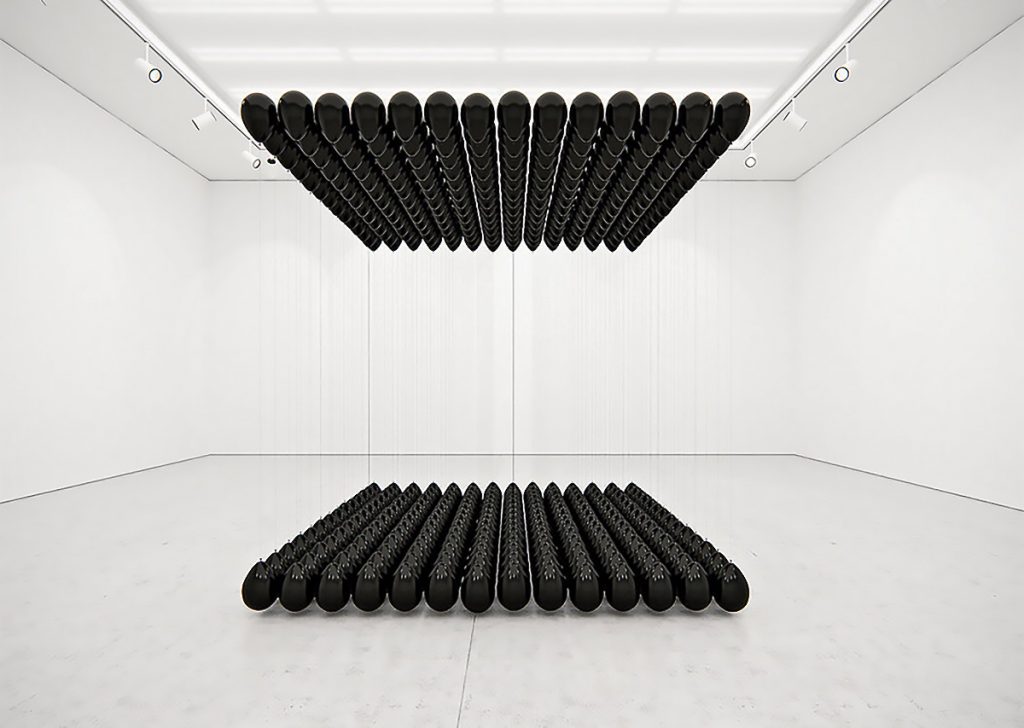
The balloons above are an installation by Lithuanian artist Tadao Cern. He describes them in the following way:
They represent nothing, a true emptiness. Which is felt every single time looking at the cloud of these black floating objects, eagerly waiting to be forced to react to our presence… react with no message, no notion. It’s just a dialog between us and them; here and now. Which will develop into a reminiscence of an idea once balloons will deflate and the work will become nonexistent again.
Tadeo Cern, The Inspiration Grid.
Balloons used in art in this way provoke a sense of deep thoughtfulness and reflection. They take on a more powerful role, moving very much away from the traditional concept of them as playthings.
The balloons below on the other hand, are positively radiating celebration. This was a display by Squarespace partnered with Geronimo Balloons to celebrate Pride Month in New York.

This relationship that balloons have to our own temporal nature means that they can be used in a darkly ironic and threatening way too. Take Stephen King’s IT, for example. He uses the figure of a clown to distort reality, taking something that is familiar to mask something much more sinister. The red balloon used in this story becomes synonymous with death and a symbol of evil.

The persona of Pennywise the Dancing Clown creates a sense of positivity and fun all wrapped up in bright clothing, funny hair, and, of course, the red balloon. However, behind it lurks something unimaginably dark. It is significant that the balloon is red: while a vibrant and exciting color, red is also a color signifying the forbidden or the dangerous. By association with the terrible events of the story, the balloon comes to represent blood. This particular red balloon holds enough power to have been used extensively in fan art.

From the horrible to the fairly disgusting! Some of the first balloons (going back as far as the Aztecs) were made of membranous parts of animals because they were flexible and could be blown up. Here are two children inflating a bladder.
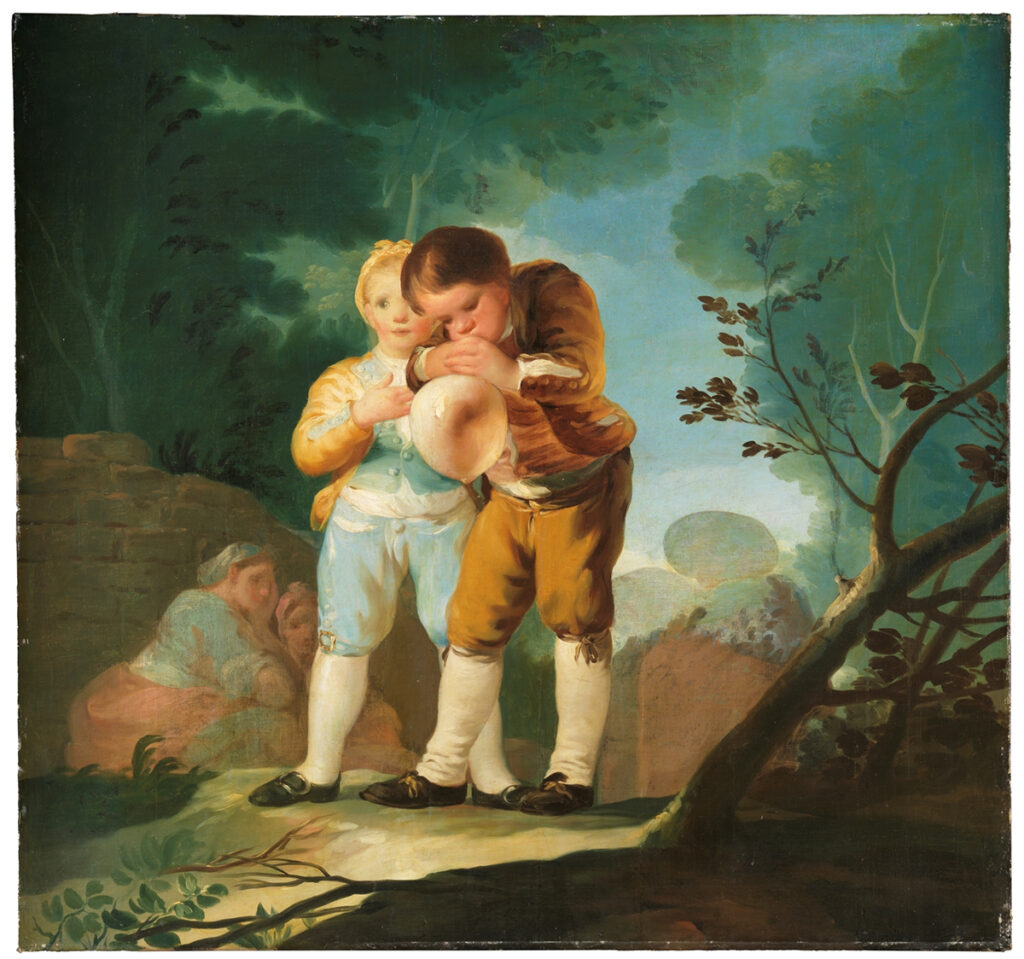
Artist Hans Hemmert used balloons to create a German Panther tank. Here we see balloons posing as a war machine. A tank is not a fun thing, it is a weapon. What does it mean to have a tank comprised entirely of brightly colored, fun balloons? At the surface level there is a contrast between materials: we know that a tank is all heavy machinery, not at all like balloons. This dichotomy is both funny and alarming.
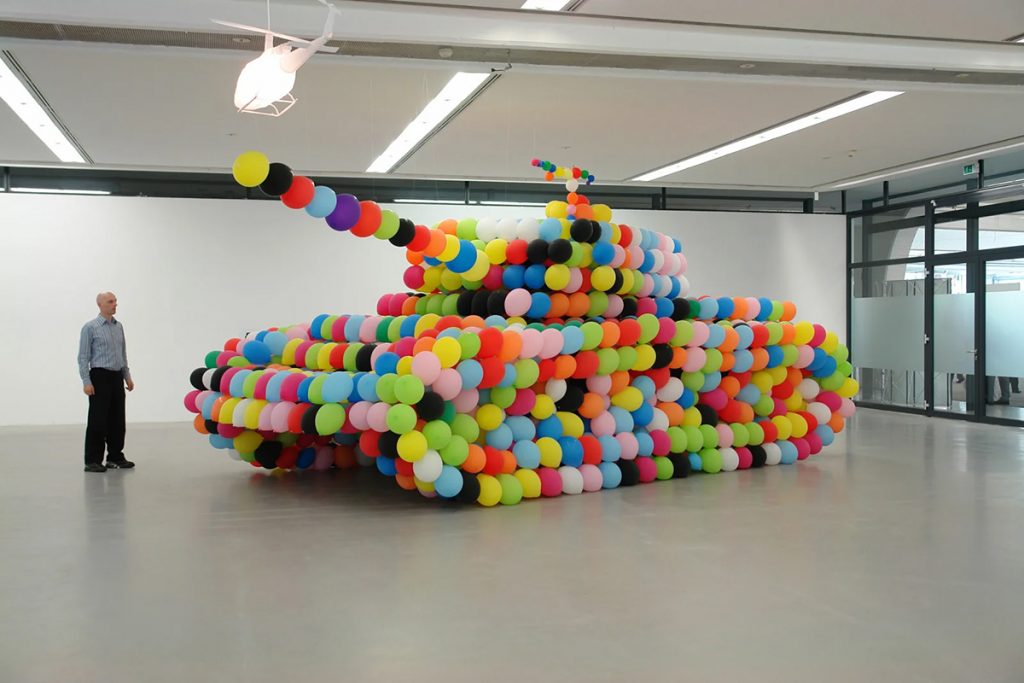
A more profound message may become more obvious over time though. The balloons gradually deflate and thus the tank slowly begins to disintegrate. As Hemmert said himself, “it becomes an anti-war statement”, empowered even further when, later, children were invited to play with the balloons as they detached and the tank completely fell apart. Perhaps the slow decline of the balloons could be a metaphor for the gradual fading of the memory or effects of war.
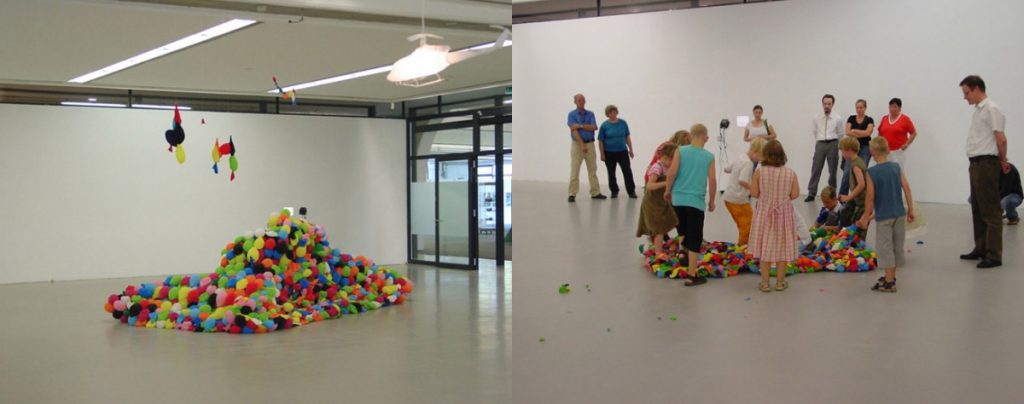
There is no doubt that children and balloons go together. From party balloons to those bought at the fairground, balloons create excitement and the thought of possessing one never fails to please. Bringing these flying objects into art can create the same sense of joy, even in dark places. A balloon brings a moment of happiness and we are attracted to that quality.
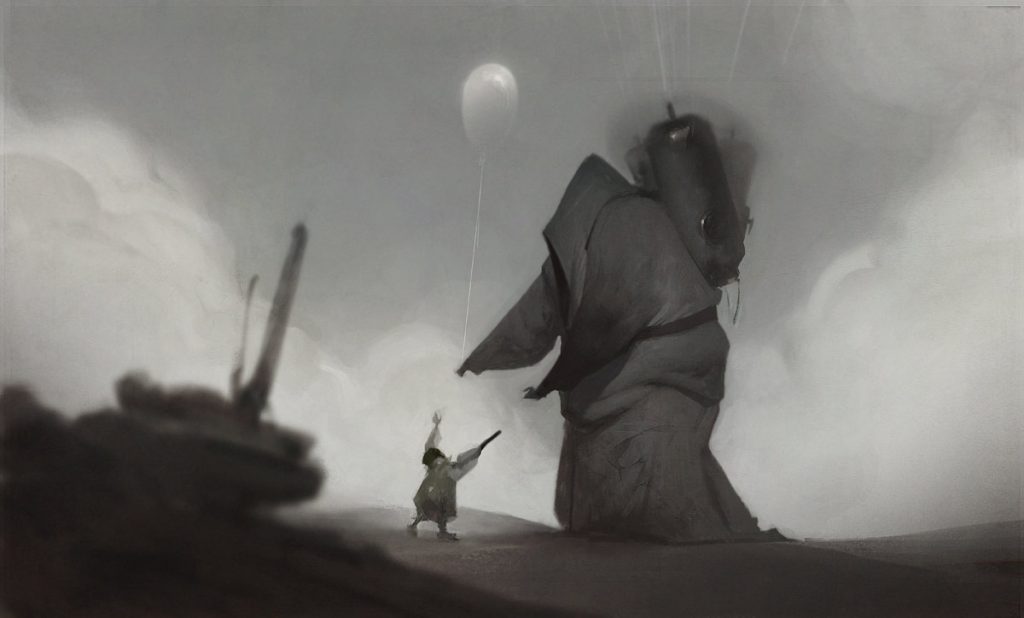
The long, latex kind of balloon, that can be twisted and shaped to make objects is one of the most fun types. While they’re not really flying objects they appear in art as balloon animals and they are hilarious! I personally like Steve Martin’s approach in the movie Parenthood (and the squeaky noises that these particular balloons make when they’re being twisted).
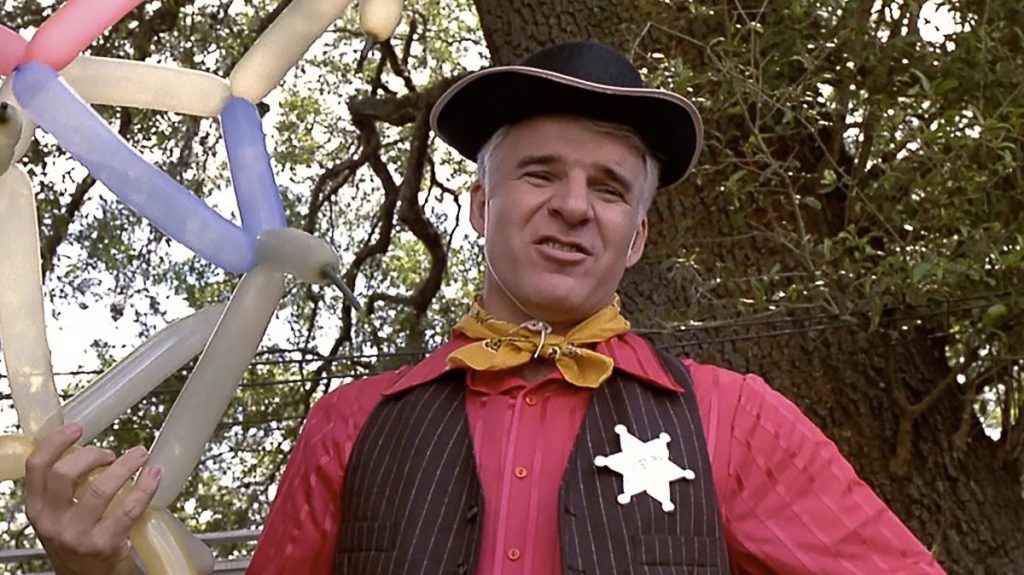
Artist Jeff Koons didn’t make balloon intestines in his art thankfully, but he did make a fantastic and unexpected balloon dog. Koons takes the familiar ideas of balloons and balloon animals but then presents them on a huge scale. If that isn’t surprising enough, we discover that the dog isn’t actually made out of balloons at all. Instead, it is made from polished, color-coated stainless steel and stands over 3 m tall. The viewer sees a light and fragile sculpture because of everything that our experience tells us about them. However, the reality is different and in this way, Koons challenges our expectations as Hemmert did with the Panther tank. One thing is certain though, Koons’ balloons will never be a flying object or art that floats away any time soon!
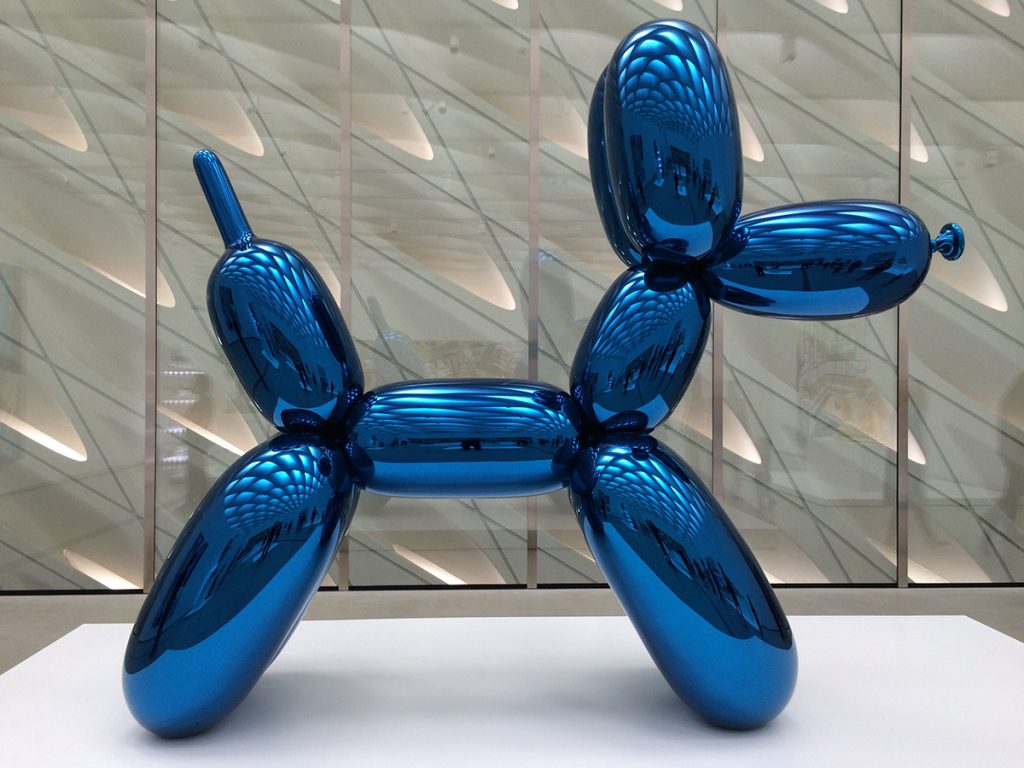
If balloon animals aren’t your thing, try some balloon people instead. Artist Larry Moss uses balloons in his art to recreate famous artworks with results that are both really funny and also very engaging. Check out this inflatable version of Grant Wood’s American Gothic!

Lastly, another hot air balloon. This is Red Balloon by Paul Klee, in chalk and oil on muslin. The cubist influence in this painting makes the minimal townscape look almost like a patchwork quilt. The soft texture of the muslin softens the hard, architectural lines to a point of blurriness that is dreamlike. Somehow the red balloon in the center remains incongruous as it floats over the buildings.
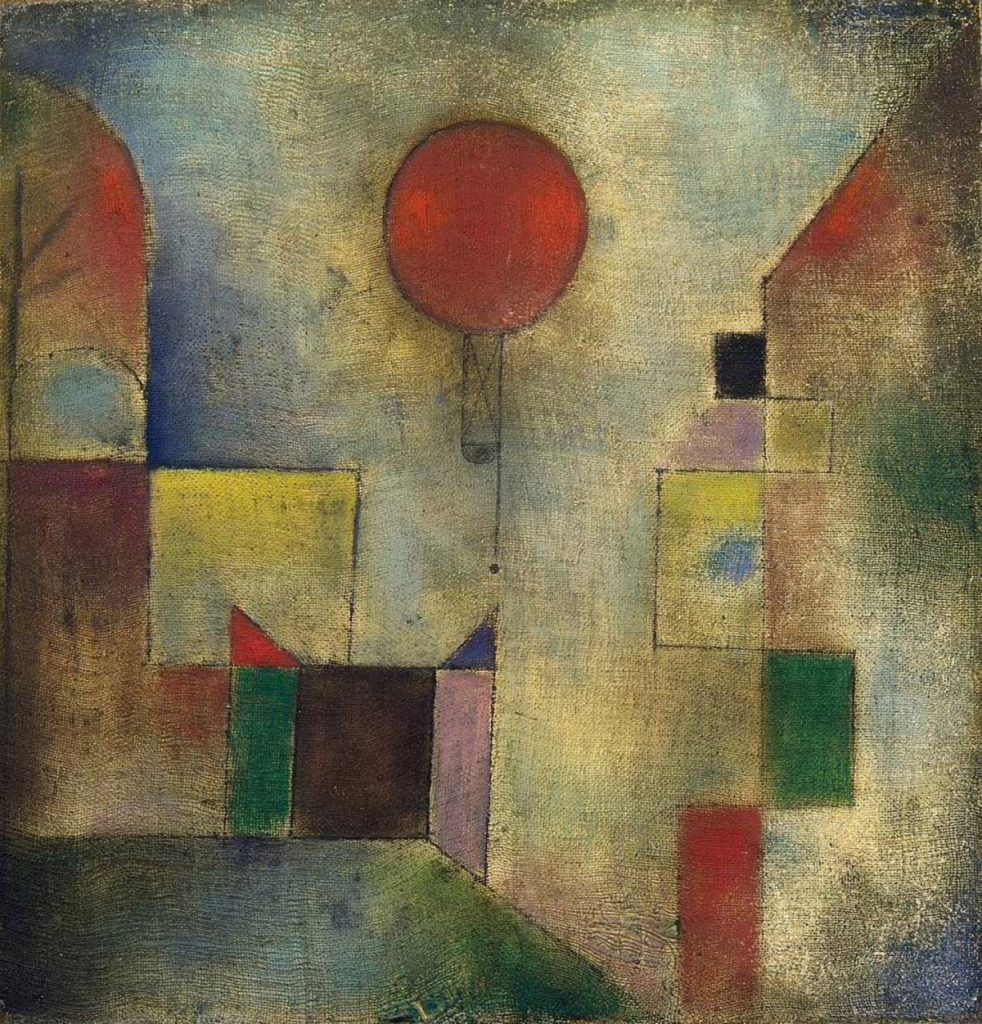


DailyArt Magazine needs your support. Every contribution, however big or small, is very valuable for our future. Thanks to it, we will be able to sustain and grow the Magazine. Thank you for your help!